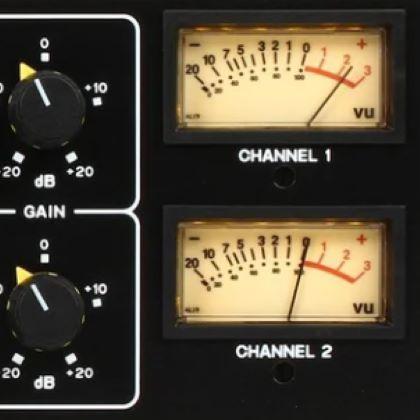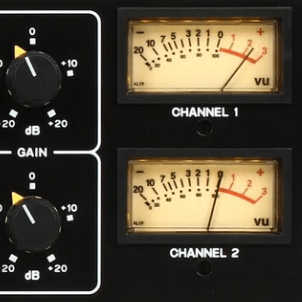Gear.
DRAWMER 1960 TUBE COMPRESSOR
- Date18/10/2023
- CatalogDrawmer 1960 Tube Compressor
- Effect Type
- Purpose

Some Background On The Drawmer 1960 Tube Compressor.
Tube Compressors At Amazon1980s – The Foundation of Drawmer Electronics: The story of the Drawmer 1960 begins with the establishment of Drawmer Electronics in the 1980s by British engineer and inventor Ivor Drawmer. Drawmer Electronics quickly gained recognition in the pro audio industry for producing high-quality audio processing equipment, particularly dynamic processors and preamplifiers.
Introduction of the Drawmer 1960: The Drawmer 1960 was introduced in the 1990s as a response to the demand for a versatile and tube-based channel strip for recording and sound reinforcement applications. It combined the functionality of a tube preamplifier, a dual-channel compressor, and a three-band equalizer in a single rack-mounted unit.
Key Features of the Drawmer 1960: The Drawmer 1960’s feature set has made it a valuable tool for audio engineers and musicians:
- Dual-Channel Design: The unit provides two independent channels, each with its own compressor, preamplifier, and EQ section. This allows for flexible signal processing for various sources.
- Tube Preamplifier: The Drawmer 1960 is known for its two 12AX7 vacuum tubes, which impart a warm and harmonically rich character to the audio passing through it.
- Compression: It features a VCA-based compressor section with controls for threshold, ratio, attack, release, and makeup gain, making it suitable for dynamic control on vocals, instruments, and more.
- Three-Band EQ: The three-band EQ section offers controls for high, mid, and low frequency bands, providing the means to shape and tailor the tonal characteristics of audio signals.
- Sidechain Inputs: The compressor section has sidechain inputs, allowing for external processing and frequency-conscious compression.
- VU Metering: Precise VU meters provide visual feedback on input levels, output levels, and gain reduction for each channel.
- Versatility: The Drawmer 1960 is versatile, capable of handling a wide range of audio sources, from vocals and acoustic instruments to drum kits and mix busses.
Continued Popularity: The Drawmer 1960 has maintained its popularity in studios and live sound applications. Its combination of tube warmth, dynamic control, and tonal shaping capabilities makes it a well-rounded and adaptable tool for audio professionals.
Ivor Drawmer and Drawmer Electronics have continued to innovate in the audio industry, introducing a range of audio processors and signal processing equipment, while the Drawmer 1960 remains an iconic part of their product lineup. Its enduring legacy speaks to its ability to meet the demands of audio engineers seeking a comprehensive and characterful channel strip for their recordings and sound reinforcement needs.
Review Of The Drawmer 1960 Tube Compressor.
As a recording enthusiast and producer, my studio is my creative sanctuary, and every piece of gear must earn its place. When I added the Drawmer 1960 Tube Compressor to my arsenal, I discovered a true sonic Swiss Army knife. Let me share my experience with this versatile and impressive unit.
Tube Warmth and Transparency: From the moment I plugged in the Drawmer 1960, I was greeted by the inviting warmth of its two 12AX7 vacuum tubes. These tubes are like the sonic equivalent of a cozy fireplace in the studio. They inject a delightful harmonic richness into every audio source that passes through.
Dual-Channel Brilliance: The Drawmer 1960’s dual-channel design is a game-changer. Having two completely independent channels, each with its compressor, preamplifier, and three-band equalizer, opens up endless creative possibilities. Whether I’m recording a delicate acoustic guitar or a powerful lead vocal, I have precise control over both channels without compromise.
Smooth and Musical Compression: The compressor section is a true gem. It’s VCA-based and delivers smooth and musical compression. I’ve used it on vocals to tame unruly dynamics and on drum overheads to add depth and character. It can handle anything I throw at it with grace.
Tonal Sculpting Power: The three-band equalizer is another ace up the 1960’s sleeve. It’s incredibly responsive, and I’ve found it to be the perfect tool for shaping the tonal characteristics of my audio sources. The ability to fine-tune the highs, mids, and lows is a creative blessing.
Versatile Studio Companion: The Drawmer 1960 doesn’t shy away from any challenge. It’s versatile enough to be at home in front of a microphone, in the signal chain of an instrument, or on a mix buss. It’s become my go-to choice for both tracking and mixing. The sidechain inputs add a layer of creativity by allowing me to sculpt the compression based on specific frequencies.
Visual Feedback: The unit’s VU meters provide that satisfying visual feedback I crave in the studio. I can easily monitor input and output levels, as well as gain reduction, for each channel. It’s an old-school touch that I find indispensable.
In conclusion, the Drawmer 1960 Tube Compressor is a treasure trove of sonic delight. It’s a master of warmth, a precision tool for dynamic control, and a sculptor of tone. Its dual-channel design and the inclusion of a tube preamplifier make it an indispensable addition to any studio. Whether I’m tracking, mixing, or looking for that extra touch of character in my recordings, the Drawmer 1960 is my secret weapon. It’s a sonic Swiss Army knife, and I’m grateful to have it by my side in my creative sanctuary.
Features And Specifications Of The Drawmer 1960 Tube Compressor.
Features:
- Dual-Channel Design: The Drawmer 1960 provides two independent channels, each with its compressor, preamplifier, and three-band equalizer, offering flexibility and versatility in audio processing.
- 12AX7 Vacuum Tubes: The unit features two 12AX7 vacuum tubes in the preamplifier stage, imparting a warm and harmonically rich character to the audio signal.
- Compressor Section: The compressor uses VCA (Voltage-Controlled Amplifier) technology for smooth and musical dynamic control. It offers controls for threshold, ratio, attack, release, and makeup gain, making it suitable for a wide range of audio sources.
- Three-Band Equalizer: The three-band equalizer provides controls for high, mid, and low frequency bands, enabling precise tonal shaping and enhancing the audio signal.
- Sidechain Inputs: The compressor section includes sidechain inputs, allowing for external processing and frequency-conscious compression.
- VU Metering: The unit features precise VU meters for each channel, offering visual feedback on input levels, output levels, and gain reduction.
- Front Panel Controls: The front panel is well-organized, with clear and intuitive controls, making it easy to dial in settings and monitor your audio in real-time.
- Stereo Linking: Channels can be linked for stereo operation, providing balanced and coherent processing for stereo signals.
- Balanced XLR I/O: The Drawmer 1960 is equipped with XLR input and output connections, ensuring compatibility with professional audio equipment.
Specifications:
- Frequency Response: 20 Hz – 20 kHz (±0.5 dB)
- Total Harmonic Distortion (THD): Less than 0.35% (0 dBu at 1 kHz)
- Signal-to-Noise Ratio: Better than -86 dB (unweighted)
- Input Impedance: > 1 kΩ
- Output Impedance: < 100 Ω
- Power Requirements: 115V or 230V AC (selectable), 50/60 Hz
- Dimensions: Standard 2U rackmount size
- Weight: Approximately 8 kg
The Drawmer 1960 Tube Compressor is celebrated for its versatility, warm tube sound, smooth compression, and precise equalization capabilities. Its dual-channel design and integration of a tube preamplifier make it a valuable addition to studio setups for audio engineers and musicians seeking transparent and characterful signal processing.
The Drawmer 1960 Tube Compressor Gets Wonky.
In the hallowed halls of a recording studio, I once found myself in the midst of a hilariously peculiar session involving the trusty Drawmer 1960 Tube Compressor. The band I was working with was known for their quirky antics, and this day was no exception.
The drummer had an affinity for practical jokes, and he had a mischievous plan in mind for our dear Drawmer 1960. As we were setting up the session, he decided that the compressor needed a bit of a “visual upgrade.” So, he gathered some sticky notes and craft supplies and went to work, transforming the stoic front panel into a whimsical work of art. He adorned the knobs with googly eyes, created a comical mustache for the VU meter, and gave it a cheerful smile with a bright red nose.
Once he unveiled his “Drawm-er the Clown” creation, the entire studio burst into laughter. The Drawmer 1960 had never looked so cheerful. It became the unofficial studio mascot for the day, bringing an unexpected burst of humor and creativity to our session.
However, the laughter didn’t stop there. As we started tracking the vocals, our singer, who had a penchant for channeling his inner stand-up comedian, decided to play along. He gave “Drawm-er the Clown” a voice, narrating the compressor’s reactions to the music. With each compression, “Drawm-er” chimed in with exclamations like “Squish! Squash!,” “I’m feeling the groove,” and “More compression, please!”
The studio atmosphere quickly turned into a sideshow of musical comedy, with the Drawmer 1960 at the center of attention. It seemed that our jester drummer and comedian vocalist had found their muse in “Drawm-er,” who was now an honorary band member.
The hilarity continued as we captured “Drawm-er’s” commentary on the final mixdown. The moments of whimsy added an unexpected layer of joy to our studio experience, proving that sometimes, even the most serious pieces of gear can embrace their inner clowns.
As the session came to a close, we removed the sticky notes and returned the Drawmer 1960 to its normal, non-clownish state. But the memories of our day with “Drawm-er the Clown” remain etched in our studio’s history, reminding us that music is not just about precision and technique but also about finding moments of laughter and creativity along the way. The Drawmer 1960 had not only shaped our sound but had also given us a day of pure, unexpected hilarity.
Where To Get Your Hands On A Drawmer 1960 Tube Compressor.
You can purchase the Drawmer 1960 Tube Compressor from a variety of sources, including authorized dealers, pro audio equipment retailers, and online marketplaces. Here are some common places where you can find the Drawmer 1960 for purchase:
- Authorized Drawmer Dealers: Drawmer has a network of authorized dealers and distributors around the world. You can visit the official Drawmer website to find a list of authorized dealers in your region. Purchasing from authorized dealers ensures you receive genuine products and support.
- Pro Audio Equipment Retailers: Many pro audio equipment retailers, both physical stores and online, carry the Drawmer 1960 and provide detailed product information and customer reviews.
- Online Music and Audio Equipment Retailers: Websites like Sweetwater, Vintage King, Thomann, Guitar Center, and others often stock the Drawmer 1960 and provide online purchasing options.
- eBay and Reverb: Online marketplaces like eBay and Reverb may have both new and used Drawmer 1960 compressors available from various sellers. Be sure to check the seller’s ratings and reviews for a trustworthy transaction.
- Drawmer’s Official Website: You can also explore the Drawmer website for information on their products and to inquire about direct ordering options.
Before making a purchase, it’s advisable to compare prices and check for any available deals or promotions from different retailers. Additionally, consider the warranty and return policy offered by the seller to ensure a smooth buying experience. Keep in mind that availability and pricing may vary, so it’s a good idea to confirm the product details with the seller before making a purchase.

